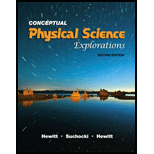
What makes a saturated fat saturated?
The character which is responsible for the saturation of saturated fats.
Answer to Problem 7RQ
The presence of single covalent bond in a fat molecule makes it saturated.
Explanation of Solution
The saturated organic compounds are those which are composed of sufficient number of hydrogen atoms in such a way that there is not any multiple bond present in them. The absence of multiple bonds in such kind of organic compounds makes then a saturated compound.
Thus, in the saturated fat molecules, the hydrogen atoms are bonded by single covalent bond with each carbon atom as the results of this, the whole fat molecule is considered as a saturated.
Conclusion:
The nature of bond between the carbon atom and the carbon and hydrogen atom in a saturated fat molecule is single covalent bond. This makes the saturated fat saturated.
Chapter 23 Solutions
Conceptual Physical Science Explorations
Additional Science Textbook Solutions
Conceptual Physics (12th Edition)
Sears And Zemansky's University Physics With Modern Physics
Essential University Physics: Volume 1 (3rd Edition)
College Physics
College Physics: A Strategic Approach (4th Edition)
Lecture- Tutorials for Introductory Astronomy
 College PhysicsPhysicsISBN:9781305952300Author:Raymond A. Serway, Chris VuillePublisher:Cengage Learning
College PhysicsPhysicsISBN:9781305952300Author:Raymond A. Serway, Chris VuillePublisher:Cengage Learning University Physics (14th Edition)PhysicsISBN:9780133969290Author:Hugh D. Young, Roger A. FreedmanPublisher:PEARSON
University Physics (14th Edition)PhysicsISBN:9780133969290Author:Hugh D. Young, Roger A. FreedmanPublisher:PEARSON Introduction To Quantum MechanicsPhysicsISBN:9781107189638Author:Griffiths, David J., Schroeter, Darrell F.Publisher:Cambridge University Press
Introduction To Quantum MechanicsPhysicsISBN:9781107189638Author:Griffiths, David J., Schroeter, Darrell F.Publisher:Cambridge University Press Physics for Scientists and EngineersPhysicsISBN:9781337553278Author:Raymond A. Serway, John W. JewettPublisher:Cengage Learning
Physics for Scientists and EngineersPhysicsISBN:9781337553278Author:Raymond A. Serway, John W. JewettPublisher:Cengage Learning Lecture- Tutorials for Introductory AstronomyPhysicsISBN:9780321820464Author:Edward E. Prather, Tim P. Slater, Jeff P. Adams, Gina BrissendenPublisher:Addison-Wesley
Lecture- Tutorials for Introductory AstronomyPhysicsISBN:9780321820464Author:Edward E. Prather, Tim P. Slater, Jeff P. Adams, Gina BrissendenPublisher:Addison-Wesley College Physics: A Strategic Approach (4th Editio...PhysicsISBN:9780134609034Author:Randall D. Knight (Professor Emeritus), Brian Jones, Stuart FieldPublisher:PEARSON
College Physics: A Strategic Approach (4th Editio...PhysicsISBN:9780134609034Author:Randall D. Knight (Professor Emeritus), Brian Jones, Stuart FieldPublisher:PEARSON





